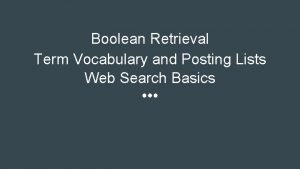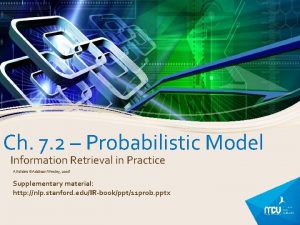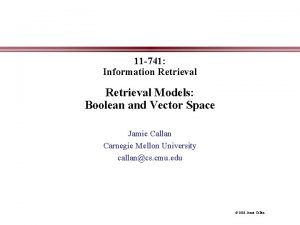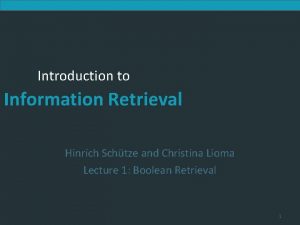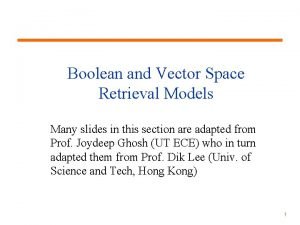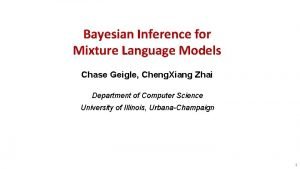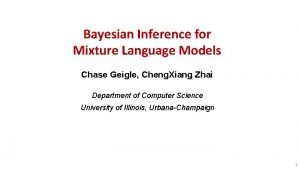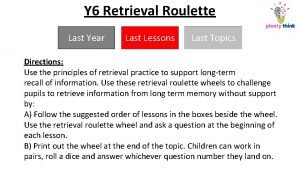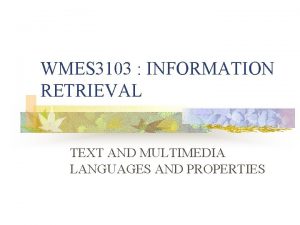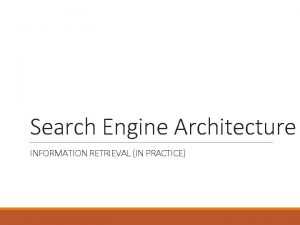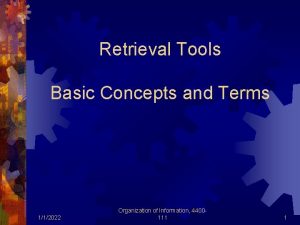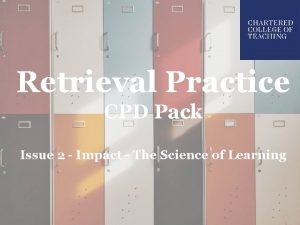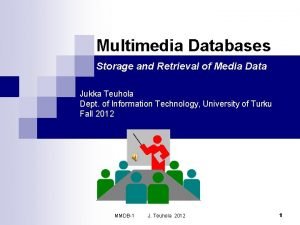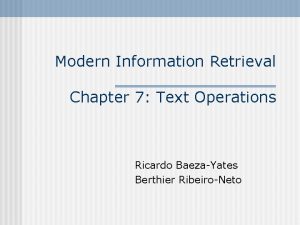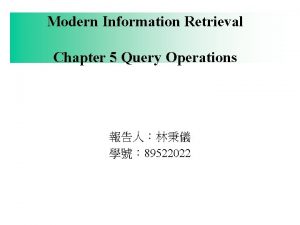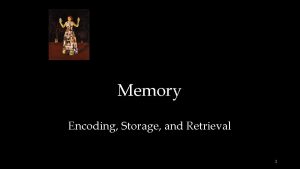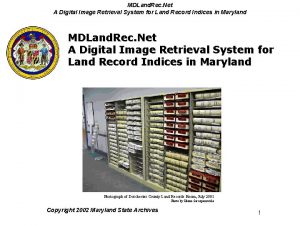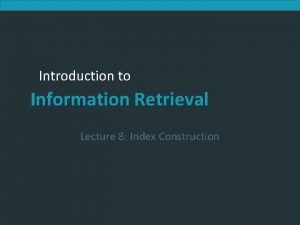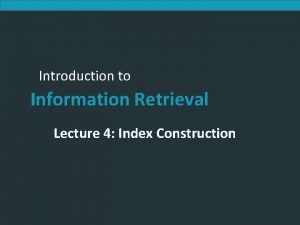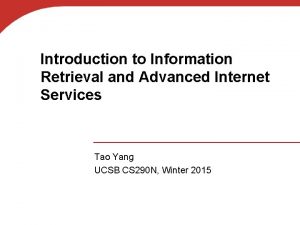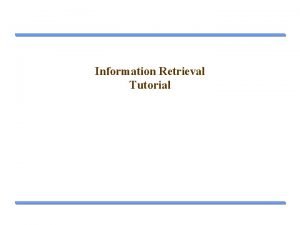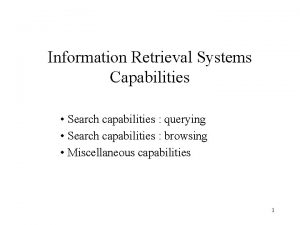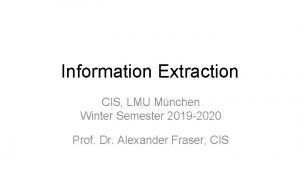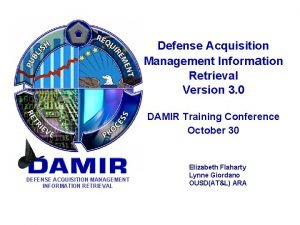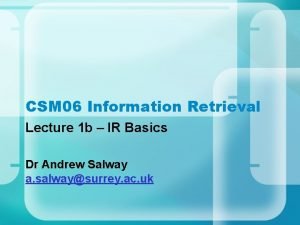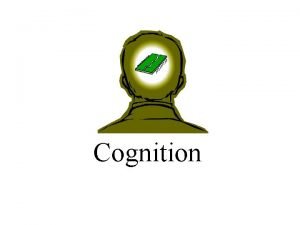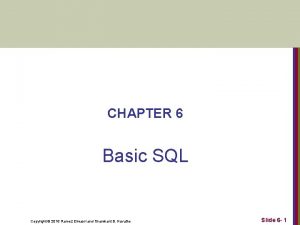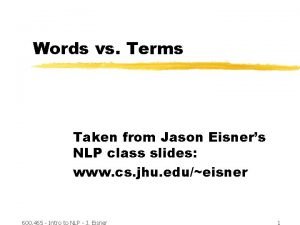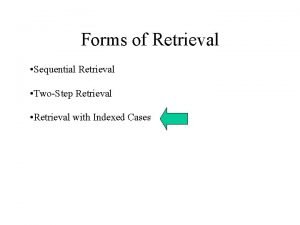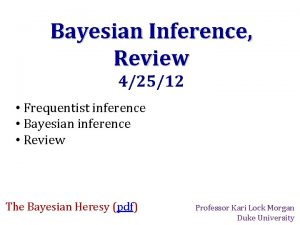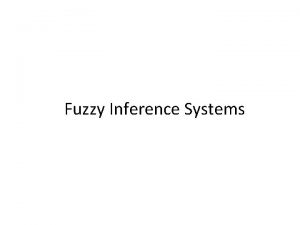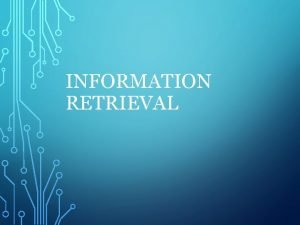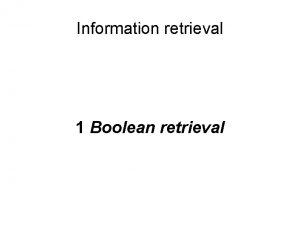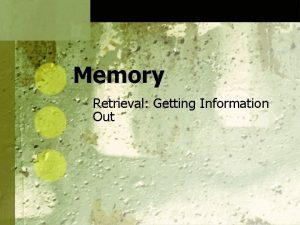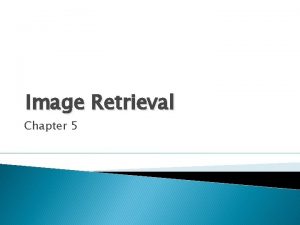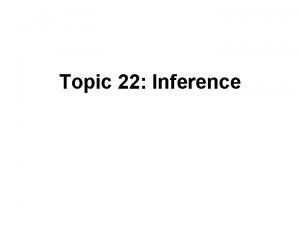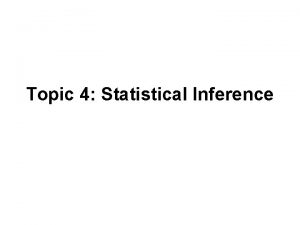Retrieval Model 4 Topic Model Inference Network Model



















![Other Techniques • (Pseudo-) Relevance Feedback Relevance Models [Lavrenko 2001] • Markov Chains [Lafferty Other Techniques • (Pseudo-) Relevance Feedback Relevance Models [Lavrenko 2001] • Markov Chains [Lafferty](https://slidetodoc.com/presentation_image/fec96556aaee6e19915cf374c0514228/image-20.jpg)




















) Rank sections matching More Field/Passage Retrieval example behavior #combine[section]( bootstrap #combine[. /title]( methodology )) Rank sections matching](https://slidetodoc.com/presentation_image/fec96556aaee6e19915cf374c0514228/image-41.jpg)





- Slides: 46

Retrieval Model (4) Topic Model Inference Network Model (Indri)

Exercise (Binary Independence Model) We have a collection of documents with respectively relevance judgements D 1 = “football cricket” (R) D 2 = “cricket termite grasshopper” (NR) D 3 = “football team hockey” (R) D 4 = “termite team goal” (R) D 5 = “obama football and hockey team” (NR) Q= “football cricket hockey termite” Rank the documents in descending order of their RSV!

BIM Exercise a query term Document R NR Term present xi = 1 pi si Term absent xi = 0 1 - pi 1 - si q=“ football cricket hockey team” football Document R NR Term present xi = 1 0. 67 0. 5 Term absent xi = 0 0. 33 0. 5 Document R NR xi = 1 0. 33 0. 5 cricket Term present Laplace Smoothing RSV 1 xi = 0 0. 67 0. 5 Document R NR RSV 4 Term present xi = 1 0. 33 0. 5 RSV 5 Term absent xi = 0 0. 67 0. 5 Document R NR Term present xi = 1 0. 67 0. 5 Term absent xi = 0 0. 33 0. 5 hockey team football + cricket = 0 RSV 2 cricket termite grasshopper cricket + termite = -0. 602 RSV 3 Term absent football cricket football team hockey termite team goal football + hockey = termite 0 = -0. 301 obama footbal and hockey football + hockey = team 0

Mixture LM: Example and exercise (1) • Document collection (2 documents) • • d 1: Xerox reports a profit but revenue is down d 2: Lucent narrows quarter loss but revenue decreases further • Model: MLE unigram from documents; = ½ • Query: revenue down P(Q|d 1) = [(1/8 + 2/16)/2] x [(1/8 + 1/16)/2] = 1/8 x 3/32 = 3/256 • P(Q|d 2) = [(1/8 + 2/16)/2] x [(0 + 1/16)/2] = 1/8 x 1/32 = 1/256 • • Ranking: d 1 > d 2 Proof this

Exercise LM (2)

Topic Models • We can think of a topic as being defined by a language model • A high-probability of seeing certain words and a low probability of seeing others

Topical Relevance • Many factors affect whether a document satisfies a particular user’s information need • Topicality, novelty, freshness, authority, formatting, reading level, assumed level of expertise, etc. • Topical relevance: the document is on the same topic as the query • User relevance: everything else! • Remember, our goal right now is to predict topical relevance

Document Language Models (1) • The topic (or topics) discussed in a particular document can be captured by its language model

Document Language Models (2) Assume that a document has the same multinomial factor for all document topics Movies= (0. 25 * 0. 50) * (0. 50 * 0. 50) = 0. 03125 Politics= (0. 95 * 0. 50) * (0. 05 * 0. 50) = 0. 011875 Sports = (0. 00 * 0. 50) * (0. 90 * 0. 50) = 0. 45 Music = (0. 50 * 0. 50) * (0. 00 * 0. 50) = 0. 25 Nature = (0. 10 * 0. 50) * (0. 10 * 0. 50) = 0. 0025 ∏P(t|D). P(t|LM)

Inference Model based on Language Model

Query Likelihood Estimate probability that document generated the query terms

Kullback-Leibler Divergence Estimate models for document and query and compare

Inference Networks (1) Language models used to estimate beliefs of representation nodes

Inference Networks (2) • Document node (D) corresponds to the event that a document is observed • Representation nodes (ri) are document features (evidence) Probabilities associated with those features are based on language models θ estimated using the parameters μ • one language model for each significant document structure • ri nodes can represent proximity features, or other types of evidence (e. g. date) •

Inference Networks (3) • Query nodes (qi) are used to combine evidence from representation nodes and other query nodes represent the occurrence of more complex evidence and document features • a number of combination operators are available • • Information need node (I) is a special query node that combines all of the evidence from the other query nodes • network computes P(I|D, μ)

Example: AND Combination a and b are parent nodes for q

Example: AND Combination • Combination must consider all possible states of parents • Some combinations can be computed efficiently

Inference Network Operators

Indri: Summary of Ranking http: //www. lemurproject. org/ • Techniques use simple multinomial probability distributions to model vocabulary usage • The distributions are smoothed with a collection model to prevent zero probabilities • This has an idf-like effect on ranking • Documents are ranked through generative or distribution similarity measures • Inference networks allow structured queries – beliefs estimated are related to generative probabilities
![Other Techniques Pseudo Relevance Feedback Relevance Models Lavrenko 2001 Markov Chains Lafferty Other Techniques • (Pseudo-) Relevance Feedback Relevance Models [Lavrenko 2001] • Markov Chains [Lafferty](https://slidetodoc.com/presentation_image/fec96556aaee6e19915cf374c0514228/image-20.jpg)
Other Techniques • (Pseudo-) Relevance Feedback Relevance Models [Lavrenko 2001] • Markov Chains [Lafferty and Zhai 2001] • • n-Grams [Song and Croft 1999] • Term Dependencies

Indri Overview http: //www. cs. cmu. edu/~lemur/Lemur. Guide. html

Indri Overview: Retrieval

GUI Indri Index Builder

GUI Indri Retrieval

Two Index Formats Key. File Indri • Term Positions • Metadata • Offline Incremental • Fields / Annotations • In. Query Language • Online Incremental • In. Query and Indri Query Languages

Indexing – Document Preparation Document Formats: The Lemur Toolkit can inherently deal with several different document format types without any modification: • TREC Text • TREC Web • Plain Text • Microsoft Word(*) • Microsoft Power. Point(*) ¡ HTML ¡ XML ¡ PDF ¡ Mbox (*) Note: Microsoft Word and Microsoft Power. Point can only be indexed on a Windows-based machine, and Office must be installed.

Indexing – Document Preparation • If your documents are not in a format the Lemur Toolkit can inherently process: 1. If necessary, extract the text from the document. 2. Wrap the plaintext in TREC-style wrappers: <DOC> <DOCNO>document_id</DOCNO> <TEXT> Index this document text. </TEXT> </DOC> – or – For more advanced users, write your own parser to extend the Lemur Toolkit.

Indexing - Parameters • Basic usage to build index: • • Indri. Build. Index <parameter_file> Parameter file includes options for • • • Where to find your data files Where to place the index How much memory to use Stopword, stemming, fields Many other parameters.

Indexing – Parameters • Standard parameter file specification an XML document: <parameters> <option></option> … <option></option> </parameters>

Retrieval • Parameters • Query Formatting • Interpreting Results

Retrieval - Parameters • Basic usage for retrieval: • • Indri. Run. Query/Ret. Eval <parameter_file> Parameter file includes options for • • • Where to find the index The query or queries How much memory to use Formatting options Many other parameters.

Retrieval - Parameters • Just as with indexing: • A well-formed XML document with options, wrapped by <parameters> tags: <parameters> <options></options> … <options></options> </parameters>

Retrieval – Interpreting Results • The default output from Indri. Run. Query will return a list of results, 1 result per line, with 4 columns: • • <score>: the score of the returned document. An Indri query will always return a negative value for a result. <doc. ID>: the document ID <extent_begin>: the starting token number of the extent that was retrieved <extent_end>: the ending token number of the extent that was retrieved

Retrieval – Interpreting Results • When executing Indri. Run. Query with the default formatting options, the output will look something like: <score> <Doc. ID> <extent_begin> <extent_end> -4. 83646 AP 890101 -0001 0 485 -7. 06236 AP 890101 -0015 0 385

Indri Query Language • terms • field restriction / evaluation • numeric • combining beliefs • field / passage retrieval • filters • document priors http: //www. lemurproject. org/lemur/Indri. Query. Language. html

Term Operations name example term dog “term” “dog” ordered window unordered window #odn(blue car) #udn(blue car) synonym list #syn(car automobile) weighted synonym #wsyn(1. 0 car 0. 5 automobile) any operator #any: person behavior occurrences of dog (Indri will stem and stop) occurrences of dog (Indri will not stem or stop) blue n words or less before car blue within n words of car occurrences of car or automobile like synonym, but only counts occurrences of automobile as 0. 5 of an occurrence all occurrences of the person field

Field Restriction/Evaluation name example behavior dog. title counts only occurrences of dog in title field restriction dog. title, header dog. (title) evaluation dog. (title, header) counts occurrences of dog in title or header builds belief b(dog) using title language model b(dog) estimated using language model from concatenation of all title and header fields builds a model from all title text for #od 1(trevor strohman). person(title) b(#od 1(trevor strohman). person) - only counts “trevor strohman” occurrences in person fields

Numeric Operators name example behavior less greater #less(year 2000) #greater(year 2000) #between(year 1990 2000) #equals(year 2000) occurrences of year field < 2000 year field > 2000 between equals 1990 < year field < 2000 year field = 2000

Belief Operations name example combine #combine(dog train) behavior #weight(1. 0 dog 0. 5 train) #wsum(1. 0 dog 0. 5 dog. (title)) 0. 5 log( b(dog) ) + 0. 5 log( b(train) ) 0. 67 log( b(dog) ) + 0. 33 log( b(train) ) log( 0. 67 b(dog) + 0. 33 b(dog. (title)) ) not #not(dog) log( 1 - b(dog) ) max #max(dog train) or #or(dog cat) weight, wand wsum returns maximum of b(dog) and b(train) log(1 - b(dog)) * (1 - b(cat)))

Field/Passage Retrieval name field retrieval passage retrieval example behavior return only title fields ranked according to #combine(query) #combine[title]( - beliefs are estimated on each query ) title’s language model -may use any belief node dynamically created passages of #combine[passage 200: length 200 created every 100 words 100]( query ) are ranked by #combine(query)
) Rank sections matching](https://slidetodoc.com/presentation_image/fec96556aaee6e19915cf374c0514228/image-41.jpg)
More Field/Passage Retrieval example behavior #combine[section]( bootstrap #combine[. /title]( methodology )) Rank sections matching bootstrap where the section’s title also matches methodology . //field for ancestor. field for parent

Filter Operations name example behavior filter require #filreq(elvis #combine(blue shoes)) rank documents that contain elvis by #combine(blue shoes) filter reject #filrej(shopping #combine(blue shoes)) rank documents that do not contain shopping by #combine(blue shoes)

Document Priors name example behavior prior #combine(#prior(RECENT) global warming) treated as any belief during ranking -RECENT prior could give higher scores to more recent documents RECENT prior built using makeprior application

Contoh lain INQUERY

each term occurs once for each class KUIS 5

Smoothing • Document texts are a sample from the language model • • Missing words should not have zero probability of occurring Smoothing is a technique for estimating probabilities for missing (or unseen) words lower (or discount) the probability estimates for words that are seen in the document text • assign that “left-over” probability to the estimates for the words that are not seen in the text •
 Example of clincher sentence
Example of clincher sentence Narrow
Narrow Boolean retrieval model in python
Boolean retrieval model in python Probabilistic model information retrieval
Probabilistic model information retrieval Advantages and disadvantages of boolean retrieval model
Advantages and disadvantages of boolean retrieval model Christina lioma
Christina lioma Boolean vector
Boolean vector Chase geigle
Chase geigle Chase model inference
Chase model inference Comparison between virtual circuit and datagram network
Comparison between virtual circuit and datagram network What is topology in computer
What is topology in computer Features of peer to peer network and client server network
Features of peer to peer network and client server network Network systems design using network processors
Network systems design using network processors Network centric computing and network centric content
Network centric computing and network centric content Packet switching vs circuit switching
Packet switching vs circuit switching Retrieval roulette
Retrieval roulette Multimedia information retrieval in irs
Multimedia information retrieval in irs Modal action pattern examples in humans
Modal action pattern examples in humans Sequential searching
Sequential searching Search engine architecture in information retrieval
Search engine architecture in information retrieval Basic retrieval tools
Basic retrieval tools Retrieval practice cpd
Retrieval practice cpd Puldow
Puldow Retrieval capp
Retrieval capp Precision recall information retrieval
Precision recall information retrieval Storage and retrieval technologies in multimedia
Storage and retrieval technologies in multimedia Text operations in information retrieval
Text operations in information retrieval Query operations in information retrieval
Query operations in information retrieval Memory encoding techniques
Memory encoding techniques Long term storage and retrieval
Long term storage and retrieval Mdlandrecs
Mdlandrecs Ora-12638 credential retrieval failed kerberos
Ora-12638 credential retrieval failed kerberos Recall skip pointers: what is skip span?
Recall skip pointers: what is skip span? Index construction in information retrieval
Index construction in information retrieval Spimi
Spimi Which internet service is used for information retrieval
Which internet service is used for information retrieval Information retrieval tutorial
Information retrieval tutorial Wildcard query in information retrieval
Wildcard query in information retrieval Search capabilities in information retrieval system
Search capabilities in information retrieval system Link analysis in information retrieval
Link analysis in information retrieval Information retrieval lmu
Information retrieval lmu Defense acquisition management information retrieval
Defense acquisition management information retrieval Advantages of information retrieval system
Advantages of information retrieval system Long term storage and retrieval
Long term storage and retrieval Basic retrieval queries in sql
Basic retrieval queries in sql Ultimate cause of behavior
Ultimate cause of behavior Information retrieval nlp
Information retrieval nlp


